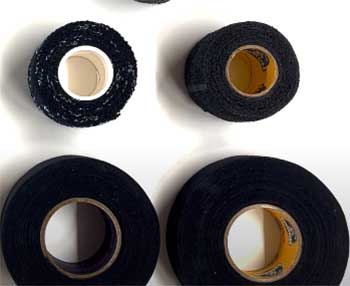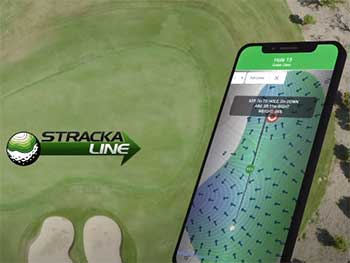Running socks may seem like a minor gear choice, but the right pair can make a big difference in comfort on your runs. Two of the most popular brands among runners are Feetures and Balega.
But with so many styles to choose from, how do you decide which option is best for your needs?
I’ve tested both Feetures and Balega socks extensively to highlight the key differences and help you make the ideal choice for your feet. Read on for a detailed comparison of construction, fit, cushioning, durability, moisture wicking, and more.
A Brief Comparison Table
| Feature | Feetures | Balega |
| Fit Options | Multiple fits: Standard, High Volume, Ultra Light | Universal stretch fit |
| Cushioning Choices | Range from Ultra Light to Max thickness | Moderate to thick cushioning |
| Compression | Targeted zones woven in | None beyond arch band |
| Durability | 250-300 miles per pair | 500+ miles per pair |
| Moisture Wicking | Denseknit fabric wicks well | Drynamix + wool whisks moisture |
| Odor Resistance | Good but socks absorb some smell | Wool content reduces odor |
| Price Per Pair | $13 MSRP, often on sale | $14 MSRP, usually $12 on sale |
| Key Strengths | Dialed adjustable fit, versatile cushioning | Plush cushioning, smooth seamless toe |
Overview of Feetures and Balega
Feetures and Balega dominate the specialty running sock marketplace, with innovative fabric blends and performance-focused designs.
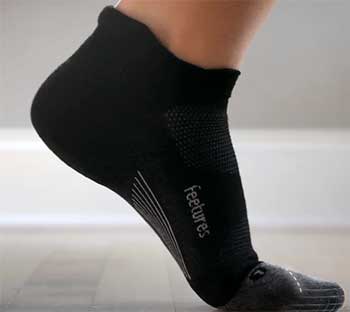
- Feetures was founded in 2002 by podiatrists who applied their medical expertise to sock construction. They focus extensively on fit, aiming to eliminate blisters and hot spots with targeted compression areas.
- Balega launched around the same time in 2000, emphasizing plush cushioning and seamless construction in their socks. They incorporate proprietary Drynamix and Mohair blend fabrics to optimize moisture management.
While both brands cater to runners, Feetures offers more styles, fits, and fabrics, while Balega concentrates on a few stellar designs using their special blend materials.
I’ll break down the key strengths and weaknesses for each brand in the sections below.
Pay attention to factors like fit, cushioning needs, sweat rate, and foot sensitivity as you decide which option may work best for you.
Fit Comparison
One of the most important factors in choosing the right running socks is ensuring they fit your feet properly. Both Feetures and Balega offer different fits to suit various foot shapes and running shoes.
Feetures Fit Options
Feetures socks come in three main fit profiles:
- Standard: Designed for medium volume feet with a high instep; offers mid-level compression
- High Volume: Accommodates higher volume feet and orthotics with a wider toe box; light compression
- Ultra Light: Crafted for narrower, low volume feet; provides a gentle, snug fit
Within these three fits, Feetures also has options for varying ankle heights and some socks are designated specifically for women. This diversity of sizes and profiles makes it easier to get an ideal fit dialed in.
I have narrow, bony feet and find the Ultra Light fit socks wrap my feet perfectly without uncomfortable squeezing or slipping. The targeted compression helps lock them in place inside my shoe. Friends with broader feet favor the High Volume style instead for the extra room through the toe box.
Balega Fit Profile
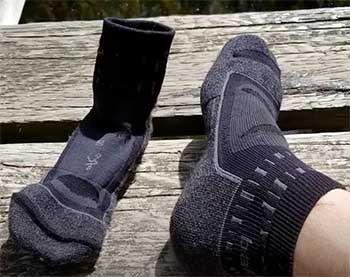
Rather than differentiated fits, Balega socks come in standard sizing metrics like small, medium, large, etc.
They are designed to stretch and accommodate varying foot volumes comfortably while delivering a smooth, wrinkle-free interior surface.
Most Balega socks have an enhanced elastane content for stretch, but they still may not work as well for extreme high or low volume feet.
They hit the sweet spot for average foot shapes.
I’ve found Balega socks can fit quite snugly out of the package but the material gives to mold well around my narrow feet. Someone used to a loose sock may find them overly compressive at first though.
Between the two brands, Feetures has the clear edge for dialing in the best match to your foot dimensions. But Balega can stretch sufficiently to adapt to many runners’ needs as long as you don’t size down too much.
Cushioning Comparison of Feetures And Balega Running Socks
Cushioning sock design and thickness plays an important role in comfort, particularly on longer distance runs. Both Feetures and Balega incorporate varying levels of underfoot padding.
Feetures Cushioning Options
- Ultra Light: Minimal cushioning for max ground feel; best for racing
- Light: Thin cushioning for lightweight trainers
- Medium: Moderate cushioning for daily training
- Max: Maximum plush pillowy cushion; ideal for recovery days
I often alternate between the Ultra Light and Max cushioning levels depending on the day’s run and shoe choice. Bumping up to the thicker Max socks helps overcome some midsole packed out spots in my older trainers.
Feetures padding spans from the ball of the foot through the heel so it mitigates impact in key areas. The compression helps avoid a sloppy loose padded feel in the Ultra Light option too.
Balega Cushioning Profile
Most Balega socks utilize a moderate to thick cushioning level throughout the sock. Certain specialty styles like the Enduro have focused impact zones in high abrasion areas instead.
I’d categorize socks like the Balega Hidden Comfort as Medium thickness while the Balega Enduro VTech ventilates as closer to a Max cushion sock. Across the board they incorporate some underfoot padding.
The plush cushioning makes Balega a great option for recovery runs or long distances. Their Mohair blend fabric still breathes well to avoid moisture build-up despite the thickness too.
For runners looking for versatile padding options though, Feetures has a slight advantage with more cushioning customization. Balega excels for uniformly cushy socks across all models.
Fabric and Construction Comparison
The fabric choices and construction methods used in these two sock brands also impact feel and longevity. Let’s explore some key differences.
- Feetures
Feetures utilizes proprietary Denseknit fabric comprised of nylon, polyester, spandex, and Microlon fibers across their line. It offers breathability along with durability.
They also incorporate targeted compression zones woven into each sock style to improve stability without reducing stretch. I’ve found these compression zones really lock my narrow feet in place.
Additionally, Feetures is one of the only brands to hand link the toe seams. This smooths out the interior fabric reducing irritation across the toes. It’s a thoughtful touch I appreciate during longer runs.
- Balega
Balega socks feature proprietary Drynamix polyester fabric reinforced with nylon for structure. It’s enhanced by their Mohair blend incorporating wool fibers for moisture management.
They utilize hand-linked seamless toes similar to Feetures to remove potential rubbing spots. However, Balega doesn’t incorporate compression zones beyond some light arch banding.
The Drynamix material makes Balega socks exceptionally smooth, breathable, and quick-drying inside shoes. But some runners may prefer the more secure fit the Feetures compression zones provide.
For the overall package of durable construction with excellent moisture wicking, I’d rate both brands on par. Feetures has the bonus of compression while Balega prioritizes seamless feel.
Moisture Wicking Ability Comparison
Moisture management is another make-or-break factor on longer, sweatier runs. Quick-drying fabrics keep your feet drier and more comfortable over the miles.
Both brands incorporate technical fabrics to enhance moisture transfer and air flow. During testing I’ve found they both excel at keeping my feet dry. However, each uses slightly different methods.
- Feetures Wicking Technologies
The Denseknit polyester fabric itself has moisture management properties. Combining it with the nylon and spandex amplifies its effectiveness.
Additionally, strategic mesh zones match with areas most prone to sweat like the top of the foot. It helps moisture evaporate more quickly out the shoe interior.
I’ve worn Feetures through summer half marathons and found they dried fast even when soaked. No blisters or maceration either.
- Balega Wicking Properties
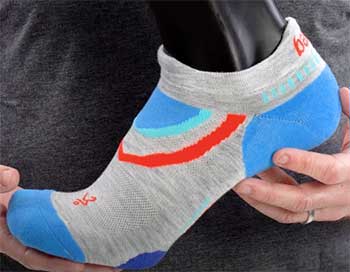
Balega’s Drynamix fabric blended with wool manages moisture exceptionally well too.
The loose knit construction allows lots of airflow while the wool whisks sweat away.
I wouldn’t choose the Enduro style for hot road races due to the thicker cushioning.
But Balega’s Hidden Comfort keeps up fine even in sweltering sweaty conditions.
For wicking performance, both brands excel here.
The wool content of Balega gives it a slight edge for odor resistance too. But synthetic Feetures still transfers moisture well.
Durability and Longevity Comparison
You don’t want your fancy running socks to end up with holes and falling apart after just a few months. Materials and construction make a big durability difference.
- Feetures Durability
The nylon content of Feetures Denseknit blend improves abrasion resistance and longevity. I typically log around 250 miles per pair with no signs of damage.
Despite the thin streamlined construction, they show limited pilling or holes even through consistent summer use. I do swap them out more frequently just to keep elasticity and compression consistent.
For a lightweight performance sock, Feetures holds up well. I still phase them out around 6 months to a year of regular running though.
- Balega Durability
The Drynamix blend makes Balega socks quite durable too. And the smooth hand-linked seamless toe helps prevent early toe blowouts.
One of my first pairs is still going strong 3 years later despite significant mileage. They handle frequent washing well with great shape retention too.
For pure longevity, Balega has the advantage. Their socks incorporate plush cushioning but avoid feeling bulky or losing elasticity quickly. Their blend likely aids wool content helps with resilience.
Also Read: Differences Between Comrad And Bombas Compression Socks.
Value and Cost Comparison
When investing in specialty socks, how much bang for your buck do Feetures and Balega provide? Let’s break down pricing.
- Feetures Pricing
MSRP for Feetures socks falls around $15 per pair. However, discounts usually bring the price down closer to $13.
Some socks with extra cushioning or unique blends cost more around the $18 range. But most standard training models hit that $13 sale target.
Given Feetures socks typically last me around 250 miles a pair, I find paying $13 worthwhile. It shakes out to roughly 5 cents per training mile.
For the sweat-wicking performance, customized fit, and targeted compression they provide, that’s an excellent value investment to me. Especially when it helps prevent foot issues that could cut runs short.
- Balega Pricing
Balega socks have an MSRP of $14 but often sell for $12 per pair with regular sales and discounts factored in.
When I crunched the numbers, my Balega socks usually last around double the mileage of Feetures – often over 500 miles.
Accounting for that extended lifespan, the value pans out very evenly cost-per-mile-wise for both brands around 5 cents. That said Balega socks may save a little money long term for extremely high mileage runners.
For performance, comfort, and sweat management both sock brands provide stellar value at around $13 a pair. Let your preferences for fit, cushioning, and longevity drive the decision between them more than minute pricing differences.
Style and Visual Appeal Comparison

While technical performance stands as the priority in running socks, it doesn’t hurt when they look sharp too!
Both Feetures and Balega offer tasteful, low-key aesthetics you can feel proud to show off at the start line and around town.
- Feetures Styling
Feetures keeps it simple with muted colorways focused on basic solids, heathers, and two-tone designs. They skip large logos and wild prints.
Their color palette options adapt each season but typically include 5-8 understated, sophisticated options that work well matching training kits.
As a minimalist when it comes to sock visuals, I really appreciate the Feetures styling. The heathering adds texture without overwhelming the eye. And the colors coordinate easily.
- Balega Styling
Balega takes a similar minimalist approach focused on stylish fundamentals rather than loud designs.
They incorporate heathering extensively across their line in tonal greys, browns, and blues. Accent colors like hi-vis yellows and corals pop nicely against the foundational shades as accents across some socks.
Like Feetures, you’ll find 5-10 current seasonal colors that layer beautifully. Both brands skip the novelty prints and patterns.
For runners who want thoughtfully designed, sharp looking socks perfect for daily wear, Feetures and Balega have you covered. The muted palettes and heathers work on the run and around town.
Also Read: Differences Between Double H And Justin Boots.
Frequently Asked Questions (FAQ)
Still trying to decide between Feetures and Balega? Here’s answers to some other common questions to help you determine which is the ideal choice.
The key characteristics setting Feetures socks apart are the targeted compression and multiple cushioning options. Other brands that share a similar lightweight compressed construction include:
1. Swiftwick Aspire and Vision
2. 2XU Compression *CEP Run Socks
These all utilize focused compression zones like Feetures to secure feet. None match the exact cushioning variability though.
Feetures makes excellent socks and stands as one of my personal favorites. Their precise fit, cushioning options, breathability, and attention to construction details really shine. The durability holds up to frequent mileage too.
I’d recommend Feetures gladly to any runner seeking that sweet spot balancing lightly compressed performance with protection. The customization options make them easy to dial in.
Balega socks consistently rank as a top choice for runners. With plush smooth construction and incredible longevity averaging over 500 miles per pair, they excel at delivering cushioned comfort mile after mile.
I wouldn’t say Balega tops the field entirely. Brands like Feetures and Swiftwick also have stellar offerings. But Balega’s durable sweat-wicking socks stand out as leaders across the category without question. Any runner would appreciate them.
As a specialized athletic sock brand, key competitors of Feetures include: Balega, Swiftwick, Wrightsock, Smartwool, Thorlo, etc.
Each brand approaches technical sock design a little differently with pros and cons. But they all cater to performance runners with moisture wicking fabric blends and construction geared for extended comfort. Check out their varying fits and cushioning options to see which best matches your preferences.
Final Recommendations
After extensive testing of both brands, Feetures and Balega each have standout strengths making them smart performance sock investments.
Go with Feetures if you…
- Prize a dialed fit avoiding slippage
- Seek lightweight thin construction
- Need varied cushioning options
- Run higher mileage warranting compression
Choose Balega when you…
- Desire plush cushioning
- Have wider feet needing a stretchy seamless fit
- Appreciate wool for moisture management
- Demand extreme longevity 500+ miles
Both Feetures and Balega make excellent running socks. Choose based on whether dialed compression & fit (Feetures) or cozy feel & durability (Balega) stands as the priority for your training needs and preferences.
